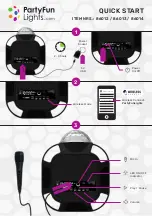
User Manual - URX_CF and URHE_CF -
9
Control is configured from the facto-
ry and it controls the unit according to
the temperature and pressure condi-
tion detected by the probes and to the
already defined thermo-regulation func-
tions.
The following operation modes are pos-
sible:
• cooling
• heating
Cooling: this is the “summer” operating
mode; the machine is configured to gen-
erate cold.
Heating: this is the “winter” operating
mode; the machine is configured to gen-
erate heat.
Setpoint setting
The activation or deactivation of the users
depends dynamically on the set thermo-reg-
ulation functions, on the temperature values
detected by the probes, and on the set set-
points.
The defined temperature setpoints are 4:
SetPoint Cooling: it is the reference setpoint
when the device is adjusted in the cool mode
(cold)
SetPoint Heating: it is the reference setpoint
when the device is adjusted in the heat mode
(hot)
SetPoint Cooling economy (COOE): it is the
reference setpoint when the device is adjust-
ed in the cool mode (cold) and in the econo-
my regime
SetPoint Heating economy (HEAE): it is the ref-
erence setpoint when the device is adjusted
in the heat mode (hot) and in the economy
regime
The setpoint can be adjusted from the key-
board by accessing the submenu “SET” (see
menu structure).
ON OFF from digital input
The input must be enabled during the first
start-up.
The digital input ID4 becomes the ON-OFF
command function. If this type of input is
enabled, the instrument shuts down all users.
Integration heaters regulator or hot water coil
(accessories) (fig. 1)
In the heating mode, the heaters or the coils
Functions
are activated when AI1 < (SET Heating -
related Offset). If the heat pump is disabled
because the outside temperature is too low,
the heaters or the coils adjust directly on the
heating set-point.
Free cooling and freeheating (optional with
related accessory)
The free cooling and freeheating func-
tions make it possible to cool or heat the
indoor environment by using the outside
air. The outside air goes into the room with-
out exchanging heat with the exhaust air
by means of a damper that lets the exhaust
air go out without passing through the heat
recovery unit. The damper control is ON/OFF.
FREE COOLING
The free cooling set is calculated by subtract-
ing from the cooling set the value equiva-
lent to the parameter “offset free cooling in
cool”. In fact, if the free cooling set coincides
with the cooling set, when the compressors
are turned off, at the same time the damper
would close down preventing thus the ener-
gy saving arising from the use of the colder
outside air.
This relationship is valid if:
• the outside temperature is lower than the
cooling set
• the indoor temperature is greater than the
outside temperature.
FREEHEATING
The freeheating set is calculated by adding
to the heating set the value equivalent to the
parameter “offset free cooling in heat”. In fact,
if the freeheating set coincides with the heat-
ing set, when the compressors are turned off,
at the same time the damper would close
down preventing thus the energy saving aris-
ing from the use of the warmer outside air.
This relationship is valid if:
• the outside temperature is higher than the
heating set
• the indoor temperature is lower than the
outside temperature.
Damper closing due to low temperature
By allowing too much cold air into the room,
the occupants well-being may suffer from
it. For this reason, if the outside tempera-
ture is lower than the “free cooling block set
point”, the damper is forced to close down.
If the outside temperature is greater than a
“free cooling block set point”, the free cooling
adjustment goes back to normal.
Recording of operating hours
The device saves to the non-volatile memory
the fan's operating hours.
The information is displayed by accessing the
special menu with the Ohr label (see menu
structure).
Defrosting
Defrosting is a function that is active only in
the heating mode. It is used to prevent the
formation of ice on the surface of the heat
exchanger. This reduces considerably the ther-
modynamic yield of the machine and poses
the risk of damages to the machine itself.
The regulation takes place depending on the
pressure.
Entering and exiting defrosting depends on
the values of the condensation probes and
on the settings of the parameters described
below.
Entering defrosting (fig. 01)
If the condensation pressure drops below
the defrosting start pressure and the com-
pressor is ON, the call counting starts. When
the counting is over, the instrument starts
the defrosting process. There is a delay time
between the compressor shut down and the
valve activation (T time in fig. 01).
This delay prevents possible liquid returns in
the compressor. During this cycle, the com-
pressor safety times are ignored.
Exit from defrosting (fig. 02)
The exit from the defrosting operation takes
place if:
• the pressure increases above the pressure at
the end of the defrosting,
the duration of the defrosting reaches a pre-
set time (max defrosting time) at the end of
defrosting,
• with the delay time between the compressor
shut down and the activation of the valve (T
time in fig. 02)
Counting mode
• The counting of the defrosting interval inter-
rupts when the pressure increases above the
Содержание URHE CF Series
Страница 1: ...RECOVERY UNIT WITH COOLING CIRCUIT USER MANUAL URX_CF URHE_CF 0619 6193641_00 ...
Страница 2: ......
Страница 14: ...NOTES ...
Страница 15: ......


































